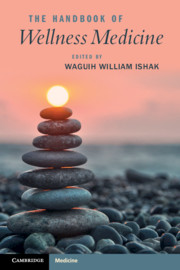Book contents
- The Handbook of Wellness Medicine
- The Handbook of Wellness Medicine
- Copyright page
- Dedication
- Contents
- Contributors
- Part I Approach to Wellness
- Part II From Illness to Wellness by Organ Systems/Disorders
- Part III Special Populations and Special Topics
- Chapter 14 Wellness Interventions in Patients Living with Chronic Medical Conditions
- Chapter 15 Wellness in Older Individuals
- Chapter 16 Wellness in Children and Adolescents
- Chapter 17 Wellness in Pain Disorders
- Chapter 18 Wellness in Cancer and Neoplastic Diseases
- Chapter 19 Wellness in Terminal Illness
- Chapter 20 Wellness Interventions in the Workplace
- Chapter 21 Wellness Interventions for Physicians and Healthcare Professionals
- Part IV Wellness Interventions
- Part V Wellness through Optimization of Work, Love, and Play
- Book part
- Index
- References
Chapter 18 - Wellness in Cancer and Neoplastic Diseases
from Part III - Special Populations and Special Topics
Published online by Cambridge University Press: 18 September 2020
- The Handbook of Wellness Medicine
- The Handbook of Wellness Medicine
- Copyright page
- Dedication
- Contents
- Contributors
- Part I Approach to Wellness
- Part II From Illness to Wellness by Organ Systems/Disorders
- Part III Special Populations and Special Topics
- Chapter 14 Wellness Interventions in Patients Living with Chronic Medical Conditions
- Chapter 15 Wellness in Older Individuals
- Chapter 16 Wellness in Children and Adolescents
- Chapter 17 Wellness in Pain Disorders
- Chapter 18 Wellness in Cancer and Neoplastic Diseases
- Chapter 19 Wellness in Terminal Illness
- Chapter 20 Wellness Interventions in the Workplace
- Chapter 21 Wellness Interventions for Physicians and Healthcare Professionals
- Part IV Wellness Interventions
- Part V Wellness through Optimization of Work, Love, and Play
- Book part
- Index
- References
Summary
Cancer is the first or second leading cause of death before age 70 years in 91 of 172 countries, ranking third or fourth in an additional 22 countries [1]. It accounts for 1 in every 6 deaths worldwide – more than HIV/AIDS, tuberculosis, and malaria combined [1–3]. GLOBOCAN reported that an estimated 18.1 million cases of cancer were diagnosed around the world, with 9.6 million cancer deaths, in 2018. Approximately 70 percent of cancer deaths occur in low- and middle-income countries, where a majority of these countries lack the medical resources and health systems to support the disease burden. The current risk of developing the disease in a lifetime is 1 in 8 for men and 1 in 10 for women [1]. Additionally, the economic impact of cancer is significant and continues to increase; in 2010, the total annual cost was estimated at approximately $1.16 trillion [3].
- Type
- Chapter
- Information
- The Handbook of Wellness Medicine , pp. 225 - 236Publisher: Cambridge University PressPrint publication year: 2020



